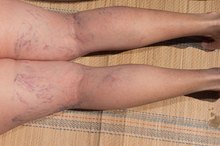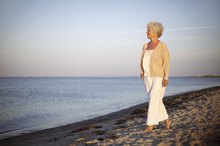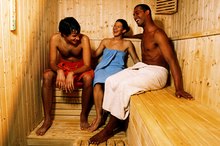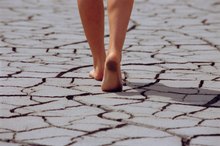Remedies for Poor Circulation in the Legs
Poor circulation in the legs can be caused by numerous conditions, such as atherosclerosis, trauma, infection and varicose veins. According to Stanford Medicine, when blood flow to the legs decreases, a person may experience the following symptoms: leg pain or weakness during exertion, swelling, soreness, tenderness, redness or warmth in the legs, pale and cool skin, numbness and tingling, and pain in the foot that occurs when lying down. Remedies for poor circulation in the legs include both active and passive techniques.
Physical Activity
According to ePodiatry.com, a lack of physical activity is one of the principal causes of poor circulation in the legs. Engaging in physical activity, especially aerobic activities such as brisk walking, bicycling and swimming, can improve circulation in the legs and the rest of the body. According to a 2000 study by R. Nami and colleagues, published in the "American Journal of Hypertension," patients with essential arterial hypertension or high blood pressure who performed aerobic exercise experienced a significant increase in capillary density. An increased capillary density--capillaries are the tiny blood vessels in which oxygen is transferred to the body's tissues--optimizes a person's circulation, creating new channels for blood flow and oxygen delivery. People with hypertension are not the only ones who can benefit, though; everybody can develop denser capillary networks and improved circulation by engaging in aerobic activity.
- According to ePodiatry.com, a lack of physical activity is one of the principal causes of poor circulation in the legs.
- According to a 2000 study by R. Nami and colleagues, published in the "American Journal of Hypertension," patients with essential arterial hypertension or high blood pressure who performed aerobic exercise experienced a significant increase in capillary density.
Massage Therapy
How to Increase Blood Circulation to the Face
Learn More
According to the American Massage Therapy Association, or AMTA, massage can increase a person's blood circulation and lymph flow. AMTA notes that the stimulation of nerve receptors during a massage therapy session results in blood vessel dilation by reflex action, which further helps increase circulation. The enhanced circulation that results from massage improves the body's ability to supply the tissues with nutrients and oxygen and remove deleterious metabolic by-products. But the effects of massage go beyond simply increasing circulation; massage can also cause changes in the blood. According to AMTA, the oxygen capacity of blood can increase 10 to 15 percent following massage.
- According to the American Massage Therapy Association, or AMTA, massage can increase a person's blood circulation and lymph flow.
- According to AMTA, the oxygen capacity of blood can increase 10 to 15 percent following massage.
Hydrotherapy
According to the High Blood Pressure Info website, hydrotherapy is a simple and effective remedy for improving circulation in the legs. Hydrotherapy, which has been practiced for hundreds of years, involves the use of water for treating health complaints ranging from pain to poor circulation. Alternating applications of hot and cold water to the lower extremities affects blood vessels in a helpful way, and promotes increased circulation. Immersing the lower limbs in hot water will stimulate dilation of the vessels near the skin's surface, which causes blood to flow toward the skin to help regulate the body temperature. After the lower extremities have been exposed to hot water, immediately immersing the legs in cold water will cause the blood vessels to close down or vasoconstrict, which shunts the blood away from the skin to maintain appropriate body temperature. Repeating this procedure several times will get the blood circulating, improving nutrient and oxygen delivery to the body's tissues.
- According to the High Blood Pressure Info website, hydrotherapy is a simple and effective remedy for improving circulation in the legs.
- Immersing the lower limbs in hot water will stimulate dilation of the vessels near the skin's surface, which causes blood to flow toward the skin to help regulate the body temperature.
Related Articles
References
- Stanford Medicine: Vascular Studies
- ePodiatry.com: Poor Circulation (Peripheral Vascular Disease)
- "American Journal of Hypertension;" Aerobic Exercise Training and Circulation; R. Nami et al.; 2000
- American Massage Therapy Association: Massage Therapy for Health and Fitness
- High Blood Pressure Info: How to Improve Blood Circulation Simply and Effectively
Writer Bio
Martin Hughes is a chiropractic physician, health writer and the co-owner of a website devoted to natural footgear. He writes about health, fitness, diet and lifestyle. Hughes earned his Bachelor of Science in kinesiology at the University of Waterloo and his doctoral degree from Western States Chiropractic College in Portland, Ore.









